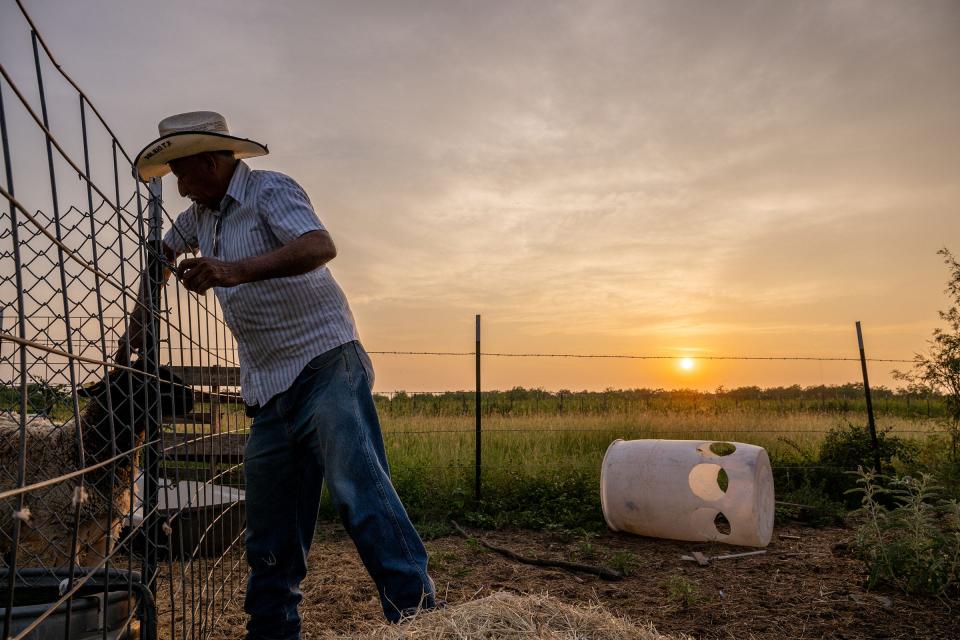Is the West's water crisis spreading? Drought blankets Midwest, America's Breadbasket
DENVER – Heavy winter snows have temporarily eased the well-documented water crisis in western states including Colorado and California, but now Midwestern farmers in America's Breadbasket are worrying more about their crops as drought worsens across Kansas, Nebraska, Missouri and Ohio.
While Midwestern dry spells aren't unusual, the current lack of rain is compounding existing problems with dry soils and streams, experts say, potentially raising the cost of cattle feed and ultimately the price Americans pay for beef.
"These are fairly serious drought conditions we're seeing right now," said Dennis Todey, the director of the Department of Agriculture Midwest Climate Hub in Ames in Iowa. "It's not a major national issue yet, but it can become a larger issue if things don't turn around soon."

What is happening with the Midwestern drought?
Many states are reporting drought conditions, ranging from "abnormally dry" to "exceptional drought." Those states include Nebraska, Kansas, Missouri, Iowa and farther east to Indiana and Ohio. Missouri Gov. Michael Parson has issued an executive order to help his state manage the dry conditions.
"The Midwest and east-central Great Plains saw mostly worsening conditions and widespread crop stress and low streamflows after another week of mostly dry weather," the federal government's U.S. Drought Monitor warned Thursday. "Heavy rains in parts of Ohio and Kentucky led to some improvements in ongoing short-term drought. Otherwise, much of the region saw conditions stay the same or worsen this week."
Drought at this time of year can be troublesome because it can stunt the growth of corn and grass, which are used primarily as food for cattle. Few Midwestern farmers irrigate their crops, and so they depend heavily on spring and early summer rains to provide water at this critical time.
Federal officials also noted reports of drought problems for vineyards, soybean growers and strawberry farmers.
The ground is already drier than it otherwise would be, thanks to a dry fall. So the moisture that does fall soaks deeper into the soil, which absorbs it like a sponge.
"It's a bit of a bigger problem because some of this area has had on and off drought for several years now, so we have so very dry ground water conditions," Todey said.
How does drought affect food prices?
A poor corn crop would help drive up feed prices, which in turn are passed along to consumers via the price they pay for beef at the supermarket. But corn and grass aren't the only feed, and soybean crops so far are doing generally OK, Todey said.
Elsewhere in the country, scorching heat in most of Texas is imperiling both grass hay growth and the survival of beef cattle, according to experts. When feed prices are high, farmers will often sell their younger, smaller cows for slaughter earlier than usual, which brings them less profit.
The federal government's January cattle survey showed the number of cattle at feedlots was down 4% over 2022.
Prices paid to beef producers have been rising steadily since mid-2020, and recently hit levels not seen since 2015. Consumer prices for beef have risen from $9.12 a pound for uncooked steak in May 2021 to $10.22 in May 2023, reflecting a 12% increase, according to federal statistics.
Some liberal politicians, including Vermont's Sen. Bernie Sanders, have criticized meatpacking companies, saying that they are raising prices beyond what's necessary to cover the higher costs paid to producers.
What happened to all the snow from this winter?
While most of the West saw historic snowfall – from Colorado to Utah, Nevada and California – the Midwest and East had mild winters with less snow. Because the vast majority of that snow fell west of the Continental Divide, levels in Lake Powell and Lake Mead are rising significantly, and drought conditions across the Southwest have generally eased.
How does climate change play into this?
It's important to remember the difference between weather and climate: Weather is what happens on any given day, while climate reflects the patterns over years or decades.
While Midwest temperatures are generally cooler in December than August, climate change means temperatures in both months are likely to be warmer on average than they used to be. The average December temperature in the Midwest rose between 2.5 and 3 degrees over the last century, according to National Weather Service records.
Similar warming temperatures are altering heat and precipitation patterns across the country, climate scientists say. For the Midwest, scientists predict higher average temperatures of 5-10 degrees by the end of the century and more frequent heavy precipitation events in the winter but fewer spring and summer rains.
This article originally appeared on USA TODAY: Midwest drought amid West's water crisis: Impact on food prices, farmers

